Gender Bending Fashion at the Museum of Fine Arts (MFA), Boston sets out to emphasise that well before Generation Z mainstreamed gender disruption, there was already an extensive history of designers, celebrities and social activists consciously embracing gender fluidity through provocative and often sumptuous sartorial choices.
Just inside, viewers are given a definition of gender-bending and wall texts offering a crash course on relevant terms such as agender, gender queer and transsexual. The show’s curator, Michelle Tolini Finamore, clearly intends for these scholarly frameworks to add weight to the fun that lies beyond when, stepping into a long rectangular gallery, you feel as though you are both at and in an elite haute couture show, sashaying down the runway to anthems like Lady Gaga’s “Born This Way”.
Jet black walls provide backdrops for skinny mannequins posing on podiums backlit in triangles of neon light and plexiglass. The exhibition design succeeds in making the show immersive but also risks trivializing its content, which thoroughly examines how controversial clothing choices (such as 20th-century women daring to “cross dress” in pants and breaking the law at times to do so), have played out amid shifts in how Western society regards gender and sexuality, patriarchy and power.
First there is a shrine to Tilda Swinton, highlighting her non-conforming role in Orlando, the 1992 film loosely based on Virginia Woolf’s classic. We observe Look 32 from Viktor&Rolf’s 2003-04 One Woman Show, the label’s ode to Swinton’s consciously genderless style. The jacket lapel falls off the mannequin’s shoulders, opening to a ruffled fan of eight unbuttoned oxford shirts. This toys with the idea of business wear serving as a kind of armour to convey a man’s reign over the boardroom table or the modern battlefield. Yet with the narrow waist and tapered trousers, the look is both male and female, corseted and frivolous.
What follows is a tour de force of Western pop culture’s great moments of binary disruption and nonconformity. Museumgoers take in the tuxedo and top hat designed by the Hollywood darling Travis Banton and worn by Marlene Dietrich for the scene in Morocco (1930) in which the siren controversially kissed another woman onscreen, and the brocaded pink dress from the Spanish designer Alejandro Gómez Palomo’s 2017 collection that turned heads when it was worn by a male model in heels and makeup. There is David Bowie’s iconic Ziggy Stardust suit by Freddie Burretti, and a spectacular floral aqua Gucci suit on loan from Vogue’s Hamish Bowles.
Mr. Bowles and designers with pieces in the show attended a swanky VIP opening, upping the coolness factor of the exhibition and of the museum in general, which uses shows like this one to reshape itself as a hip, inclusive institution with late-night hours rather than a staid Brahmin fortress of yesteryear.
Fine art threads through the exhibition, including a 19th-century painting by an unknown artist depicting two children in dresses, invoking the Victorian practice of dressing boys and girls in identical, oftentimes pink and lacy robes until age 9, when boys were “breeched” into trousers. The image shows how, even in the West, the idea of a dress as feminine is a new construct, and how clothing’s coded language somersaults over time.
The show’s mood borders on self-congratulatory—implying that after much political struggle, women wearing pantsuits, men wearing dresses or anyone wearing whatever feels right for them is increasingly applauded both on the runway and the street. Still, for those who don’t live in a bubble of privilege, the message may come across as more aspirational than realistic.

An installation view of Gender Bending Fashion at the Museum of Fine Arts, Boston Michael Blanchard


